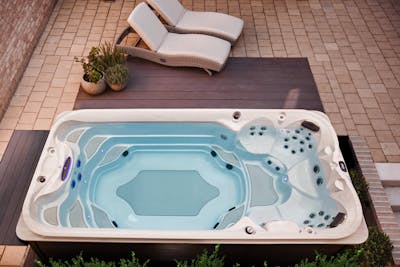A water workout is a fun and refreshing way to exercise without putting added stress and pressure on the joints. Pool exercises are not just for those who need to focus on joint-friendly forms of exercise. Some of today’s most advanced athletes turn to water workouts to enhance their training. Plus, there are some incredible proven benefits of water workouts for people of all athletic abilities. Pool exercises offer many benefits and significant health benefits, including improving quality of life by supporting mobility, reducing pain, and enhancing overall well-being.
This article will cover some of the best reasons to work out in the water and reveal 11 workouts that you can do in an exercise pool. Pool exercises are especially beneficial for older adults, individuals with chronic conditions, or those recovering from injury, and are helpful for people with limited mobility. Aquatic exercise reduces stress on joints and body weight, improves balance, and can help manage pain. If you have a chronic condition or injury, consult your doctor before starting a new pool exercise routine. Pool exercises are a beneficial form of physical activity that can help you achieve various fitness goals and improve your overall life quality. Furthermore, it will cover additional topics such as recommended pool exercise equipment to increase the intensity of your water workouts and other water fitness techniques that can enhance your workout.
Reasons to work out in the water
Good health is certainly a valid reason to give water aerobics and other water exercises a try. A recent article titled, “What makes water workouts so worthwhile?” on the Harvard Health Publishing Harvard Medical School website explores how aquatic exercise can strengthen your cardiovascular system and muscles.
Aquatic exercise also reduces the risk of falling and injury, especially for individuals with chronic conditions such as osteoarthritis or rheumatoid arthritis, by providing supportive resistance and reduced stress on joints.
In the article, Dr. Aubrey Grant, sports cardiology fellow at the Cardiac Performance Laboratory at Harvard-affiliated Massachusetts General Hospital, calls swimming “one of the best forms of cardiovascular exercise.” Grant further explains in the article that “swimming is a full-body exercise that uses nearly every muscle in your body to propel you forward. And because you’re horizontal in the water, blood doesn’t pool in your lower body like it does when you’re exercising upright.”
Water workouts are also effective for improving balance, making them particularly suitable for people experiencing pain or recovering from injury, as the reduced stress on joints allows for safer and more comfortable movement.
That combined with the pressure of the water on your body increases blood flow from your extremities toward the center of your body and your heart. Through this, your heart becomes more efficient, according to Grant. Another plus the article states: “Moving your body through water provides far more resistance than moving through air, which means swimming strengthens your muscles and cardiovascular system simultaneously.”
1. Swimming
Naturally, swimming is an excellent workout you can do in any type of pool. Doing it in an exercise pool or swim spa can enhance this workout even more. A swim spa is a hybrid between a hot tub and a swimming pool. They offer dual temperature options and jetted seating around the perimeter for relaxing as well as a central area in which you can exercise. Swim spas are designed for fitness training and feature strong jets that create a current for you to swim again.
For those seeking a more advanced workout, swimming in deep or deeper water areas of the pool can increase resistance and workout intensity, making the exercise more challenging and effective.
The added benefit of swimming in an exercise pool or swim spa is that you don’t have to turn around once you reach the edge of the pool. Instead, you are consistently swimming against that current, which can be adjusted to be more or less challenging as you increase your strength and endurance.
2. Water Walking
As simple as it sounds, walking in water provides an excellent workout without putting too much pressure on your joints. Consider wearing water shoes to help maintain traction and stability on the pool bottom during water walking.
As with swimming, you get the added benefit of resistance to enhance your walking. As you progress, try walking in deeper water to further increase resistance and intensity.
Water walking can also be progressed to jogging in the pool for a more intense, low-impact cardiovascular workout.
For proper form during water walking, keep your toes pointed forward and your feet engaged throughout the movement.
3. Lunges
Just as you might do a standard lunge on dry land, lunges can be done as a part of a water workout. Keep your feet hip-width apart, place one foot in front and one behind, then lower your body, remaining centered between your legs. Be sure to keep your front knee soft or slightly bent during the movement to prevent injury and maximize muscle engagement.
4. Squats
Another common weight room exercise, squats are a great part of a water workout too. Squats work your multiple muscle groups including your quads, hamstrings, glutes, abs and calves. Keep your feet parallel, slightly wider than shoulder-width apart, then slowly lower your body into the squat position for better control. As you perform the squat, keep your back and torso straight, then bend your knees and come up, squeezing your muscles as you return to a standing position.



















